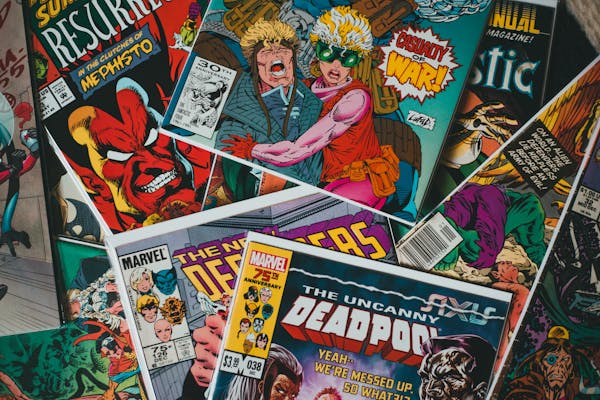Exploring the World of Antique Comic Books
The realm of antique comic books represents a fusion of history, art, and storytelling. Within their fragile pages lie narratives that have enthralled generations, offering insights into the cultural zeitgeist of their eras. Their worth extends far beyond their age or condition, encompassing tales that have shaped our imaginations and cultures.
The 5 Antique Comic Books’ Value Tips:
Understanding the Evolution of Comic Book Collecting
The Genesis of Comic Book Collecting
The concept of collecting comic books blossomed alongside the emergence of the comic book industry in the early 20th century. What began as a form of entertainment swiftly transformed into a passion for preserving and cherishing these publications as icons of popular culture. This movement laid the foundation for a market where these vibrant pages became cherished treasures.
Before comic books, cartoons thrived in England and America since the 1800s, starting as satirical prints in newspapers. Thomas Nast, a pivotal figure, used cartoons to expose political corruption, notably targeting “Boss” Tweed in 1870s New York. This art form evolved into comic books, progressing from reprint compilations to original artwork. The advent of superheroes in 1938 propelled comic books into popular culture.
Platinum Age (1897-1938)
“The Yellow Kid in McFadden’s Flats,” published in 1897, is often hailed as the first comic book, bearing the term “comic book” on its back cover. While caricatures with text have roots in the Middle Ages, comics gained traction in publications like Punch, a British humor magazine, where Golden Age illustrators refined their skills. Richard F. Outcault’s “The Yellow Kid” became a sensation, featured in two newspapers simultaneously in 1896, boosting sales for both. This strip pioneered sequential panels and word balloons, shaping the future of cartoons and comic books. Unlike modern glossy editions, “The Yellow Kid” comprised black and white newspaper strip reprints.
In 1922, “Comics Monthly” emerged as the first monthly comic book featuring newspaper reprints. “Funnies On Parade” of 1933 marked the debut of color comic books in the standard size. In 1935, National Allied Publications (later DC Comics) released “New Fun #1,” the first comic book with entirely original content. This marked the beginning of Jerry Siegel and Joe Shuster’s journey, creators of Superman, who introduced their character Slam Bradley in the March 1937 edition of “Detective Comics #1.”
Golden Age (1938-1956)
The Golden Age of Comic Books kicked off in June 1938 with Superman’s iconic debut in Action Comics #1, followed by Batman’s introduction in Detective Comics #27 less than a year later.
In October 1939, Marvel Comics’ precursor, Timely Publications, unveiled Marvel Comics #1, featuring Human Torch, Angel, and Prince Namor the Sub-Mariner. Meanwhile, Fawcett Comics introduced the superhero Captain Marvel, and DC Comics brought Flash and Green Lantern to life in 1940. Marvel’s Captain America and DC’s Wonder Woman followed suit in the subsequent year.
From 1938 to the mid-1940s, comic book popularity soared. While today’s top titles sell around 100,000 copies monthly, Superman, Batman, and Captain Marvel regularly moved to 1.5 million monthly copies.
After World War II, superhero comics faced a decline in sales, leading to the cessation of many titles. Through the mid-1950s, comics shifted toward more serious themes like crime, romance, Westerns, and horror. However, Superman, Batman, and Wonder Woman comics maintained a steady readership during this transitional phase.
Silver Age (1956-1970)
In 1954, psychiatrist Fredric Wertham ignited controversy with his book “Seduction of the Innocent,” accusing comics of corrupting American youth. Concerned, Congress summoned Wertham, leading to publishers’ creation of the Comics Code Authority (CCA) to self-regulate the industry, akin to the film industry’s MPAA.
The CCA imposed strict guidelines on comic content, leading to the cancellation of many horror and crime titles. Publishers shifted focus to reviving Golden Age superheroes and introducing new characters. The Silver Age officially began with the revamped Flash’s debut in Showcase #4 (October 1956), marking a resurgence in superhero popularity.
The late 1950s to 1960s shifted towards lighter, campier themes, epitomized by stories featuring Superbaby and bizarre team-ups like Batman and Jerry Lewis. The era embraced absurdity, which is reflected in Batman comics with characters like Batbaby and Bat-Ape. Additionally, new forms of kryptonite introduced fresh challenges for Superman.
Bronze Age (1970-1985)
The Bronze Age brought a shift towards realism in comics, led by a new generation of artists like Neal Adams, John Byrne, and Frank Miller. They replaced older artists, reshaping the style of superhero stories.
Its start is marked by the tragic death of Gwen Stacy in Amazing Spider-Man #121-122 (June-July 1973). This event challenged the notion of infallible heroes, showing their human vulnerability in a groundbreaking storyline.
In 1971, the Comics Code Authority eased restrictions, allowing for a resurgence of horror comics like The Tomb of Dracula and Ghost Rider. Socially conscious narratives also emerged, notably in Green Lantern/Green Arrow’s crusade against racism and pollution.
Diversity gained prominence by introducing minority superheroes like Storm and Black Lightning. Comics tackled severe issues, from drug addiction in Green Arrow’s sidekick to alcoholism in Iron Man, reflecting changing societal norms.

Dark Age (1985-1996)
The Dark Age dawned with Crisis on Infinite Earths, a groundbreaking series aiming to streamline DC Comics’ convoluted continuity. This 12-issue event reconciled disparate timelines, marking a significant milestone for DC.
During this era, anti-heroes rose to prominence, epitomized by works like Alan Moore’s Watchmen and Frank Miller’s Batman: The Dark Knight Returns. These gritty narratives depicted a world disillusioned with traditional superheroes, featuring darker, more complex themes.
Notable events included Superman’s death, Batman’s retirement, and Green Lantern Hal Jordan’s descent into darkness. Art Spiegelman’s Maus, a poignant tale of survival during the Holocaust, further challenged the medium’s boundaries.
However, oversaturation and a speculative market led to a sales downturn and industry turmoil. Marvel Comics’ bankruptcy in 1996 marked the end of this tumultuous period.
Modern Age (1996-Present)
The Modern Age dawned with Alex Ross’s Kingdom Come in 1996, evoking the optimism of Silver Age superheroes. Publishers streamlined operations and focused on quality over quantity. After the disappointment of Batman and Robin (1997), superhero films underwent reevaluation. The success of The X-Men (2000) reignited interest in the genre.
Despite over eighty years since Superman’s debut, the industry thrives. It embraces digital comics, enjoys success in film and TV, and maintains a strong bond with fans.
Shifting Trends in Collectibility
The parameters defining a comic book’s value have traversed diverse terrains across the ages. The classics of the golden era, with their pioneering characters and stories, continue to hold a place of prominence. However, contemporary rarities, shaped by current societal narratives and artistic innovation, have increasingly gained value in the eyes of collectors.
Evaluating Value Factors
The Significance of Condition
The condition of a comic book stands as a linchpin determining its value. From the impact of aging, wear, and restoration to the careful preservation techniques employed, the state of a comic book significantly influences its worth.
Rarity and Scarcity
The concept of rarity ties intricately with a comic book’s value. Limited print runs, unexpected surges in demand, and the elusive nature of specific editions all contribute to their desirability and, consequently, their value.
Historical Context and Cultural Impact
Beyond the narratives, the historical context and cultural impact of a comic book add layers to its value. Whether it’s tethered to a significant historical event, societal change, or a reflection of popular culture, these connections amplify the book’s significance.
Artistic & Storytelling Merit
The creative prowess behind a comic book, encompassing the quality of its artistry and the compelling nature of its storytelling, plays a pivotal role in determining its value. The creative team, from writers to illustrators, imbue each page with a unique essence that resonates with collectors.
Grading and Authentication
The Role of Professional Grading
Professional grading services serve as authoritative voices in assessing a comic book’s condition and authenticity. Their expertise and standardized grading systems provide a common ground for evaluating a book’s worth.
Authentication Techniques
Various techniques, from advanced technological methods to meticulous manual examinations, play a crucial role in authenticating rare editions. These methods safeguard against forgeries and ensure the preservation of the market’s integrity.
Trends in the Market
Market Fluctuations and Influences
The market for antique comic books is in a perpetual state of flux. Influenced by movie adaptations, TV series, and pop culture events, the demand for specific titles can soar or dip, directly impacting their value.
Emerging Collectible Categories
Certain niche categories within comic book collecting have been gaining prominence, offering potential for future appreciation. From overlooked genres to specific character arcs, these emerging categories present opportunities for astute collectors.

Collecting Strategies and Investment Tips
Building a Collection Wisely
Crafting a comprehensive collection involves strategic planning. Diversification across eras, genres, and characters is key to building a well-rounded and potentially valuable assortment.
Investment Considerations
Viewing comic book collecting as an investment requires a nuanced understanding of risks and potentials. While certain editions might promise high returns, it’s crucial to approach the endeavor with a long-term perspective, balancing passion with financial acumen.
Conclusion:
Unveiling the Hidden Treasures
The world of antique comic book collection isn’t just about monetary value. It’s a gateway to exploring our past, celebrating artistic brilliance, and comprehending the evolving dynamics of popular culture. These treasured artifacts offer an immersive journey for enthusiasts and collectors, transcending mere financial worth.




